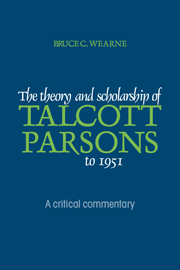Book contents
- Frontmatter
- Contents
- Preface
- Part 1 Unravelling Talcott Parsons' theoretical development
- 1 Introduction
- Part 2 Talcott Parsons: the roots of his thought
- Part 3 The development of theory
- Part 4 The theory
- Part 5 Parsons' theory as it stood at 1951
- Appendix Some recent publishing on Talcott Parsons' theory: a bibliographical essay
- List of references
- Index of names
- Index of Parsonian concepts
- Frontmatter
- Contents
- Preface
- Part 1 Unravelling Talcott Parsons' theoretical development
- 1 Introduction
- Part 2 Talcott Parsons: the roots of his thought
- Part 3 The development of theory
- Part 4 The theory
- Part 5 Parsons' theory as it stood at 1951
- Appendix Some recent publishing on Talcott Parsons' theory: a bibliographical essay
- List of references
- Index of names
- Index of Parsonian concepts
Summary
As the reader works through this book the going will get progressively more difficult. My aim, in this discussion of Talcott Parsons' contribution to sociology, has been to encourage the reader to experience something of the way Parsons' project developed, especially in the 1940s. By writing a critical commentary in this way, I wish to encourage a deepened and sympathetic critique of the theory of this ‘incurable theorist’. Two central problems are addressed here: how did Parsons develop his theory over time? and how are we to interpret his theoretical statements, especially his major ones?
The method of presentation is chronological and comparative. I compare what Parsons wrote as a professional with what he wrote earlier in his intellectual odyssey. Consequently, I have limited myself very much to what he wrote and I have, in the main, refrained from comparing his evolving theory with what it became after 1951. This, I believe, constitutes the strength and the limitation of this critical commentary.
Parsons' theoretical development, as much as his theory itself, was a complex process. Here I try to outline some of the major lines of continuity manifest in his thought up to 1951. Some of the material I discuss is new, particularly the ‘Amherst Papers’ (T. Parsons 1922, 1923) – see Chapter 3 – as well as the unpublished paper ‘Actor, Situation and Normative Pattern’ (T. Parsons 1939/40), examined at length in Chapter 7.
- Type
- Chapter
- Information
- The Theory and Scholarship of Talcott Parsons to 1951A Critical Commentary, pp. 3 - 8Publisher: Cambridge University PressPrint publication year: 1990



